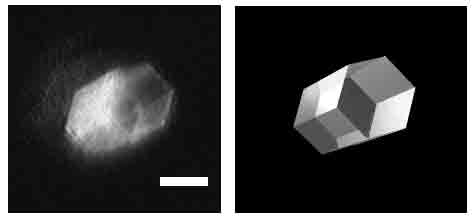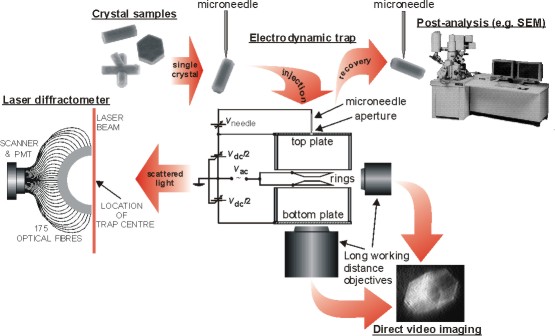Electrodynamic levitation
Electrodynamic levitation is a technique for non-contact trapping of microparticles using electric fields. The particles are charged and held stationary using a combination of static (DC) and oscillating (AC) electric fields (unlike in the famous Millikan oil-droplet experiment, where only a DC field was used). This technique was applied in the past in a wide range of single particle studies, for example mass and charge measurements, evaporation/condensation studies, light scattering measurements and photoemission experiments, on both liquid and solid particles.
In our laboratory we use electrodynamic levitation primarily to trap various atmospheric particles so that their light scattering properties can be measured. One project concentrates on microscopic ice crystals of the type found in cirrus clouds. Such clouds have a profound influence on the Earth's climate and their properties have to be incorporated into global climate models. While such models are now very accurate, cirrus clouds remain as the source of some of the greatest uncertainties because the properties of cirrus, most notably the scattering of light by ice crystals, are not yet accurately known. To circumvent various difficulties associated with studying real ice in the laboratory, we use simulated ice crystals, or ice analogues - particles with shape, size and refractive index resembling those of water ice. These include simple shapes (e.g. hexagonal columns or plates) as well as complex ones (rosettes or aggregates).

Above left: hexagonal ice-analogue crystal observed during levitation. The scale bar is 10 microns. A solid, ray-traced rendering of the shape is shown on the right. MPEG video clip (MPG - 0.31 Mb) of the crystal is also available.

The trap we have developed can be used to present a particle at a variety of orientations, so that the scattering of light incident from more than one direction can be measured. One way by which this is done is to make the particle temporarily unstable, so that it "flips" into a different orientation (Hesse et al. J. Aerosol Sci. 2002) - see the MPEG video clip (MPG - 0.89 Mb) where a small hexagonal column is shown.
The same principle can be used to carry out measurements on particles in random orientation. This situation is directly relevant to atmospheric ice crystals, which are not thought to be aligned to a significant degree with the exception of larger plates and columns. The animated image on the left shows a trapped aggregate of hexagonal columns undergoing apparently chaotic angular oscillations (a more detailed MPEG video clip is available here (MPG - 0.52 Mb)). However, the aggregate is rotating at the same time, as seen from an orthogonal direction in the image on the right (an MPEG clip is here (MPG - 0.3 Mb)). The combination of these motions provides near-complete randomization of orientation (Ulanowski et al. JQSRT 2006).
Contact
Dr Evelyn Hesse
STRI
University of Hertfordshire
Hatfield AL10 9AB
UK
tel +44 (0)1707 286170